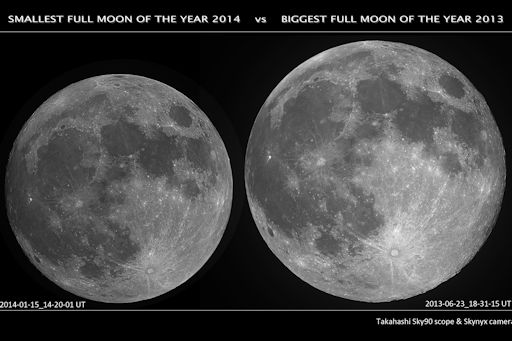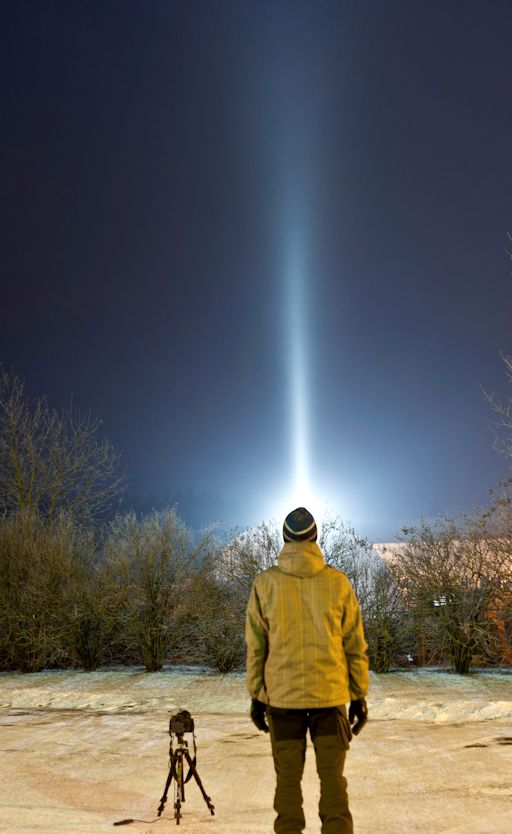When is the best time to see auroras? Where is the best place to go? And how do you photograph them? These questions and more are answered in a new book, Northern Lights - a Guide, by Pal Brekke & Fredrik Broms. | | | CHANCE OF STORMS: NOAA forecasters estimate a 35% chance of polar geomagnetic storms on Jan. 17th when a minor CME is expected to hit Earth. High-latitude sky watchers should be alert for auroras competing with bright moonlight. Aurora alerts: text, voice. SMALLEST FULL MOON OF THE YEAR: Last night's full Moon was the smallest of the year, as much as 14% smaller and 30% dimmer than other full Moons of 2014. But could you tell the difference? When the Moon is high in the sky with no reference points nearby, a big Moon and a small Moon look much the same. To set the scale of the phenomenon, Karzaman Ahmad of the Langkawi National Observatory in Maylasia photographed last night's Moon and placed it alongside a photo of the largest Moon from 2013: 
"It really was smaller!" he says. Full Moons vary in size and brightness because of the oval shape of the Moon's orbit. The Moon follows an elliptical path around Earth with one side ("perigee") about 50,000 km closer than the other ("apogee"). Last night's full Moon was a distant apogee Moon--less big and bright, but no less beautiful. Browse the gallery for more examples. Realtime Space Weather Photo Gallery LIGHT PILLARS: Winter is unfolding around the northern hemisphere. As temperatures drop, pillars of light are springing up from ground. Janis Satrovskis of Valmiera, Latvia, photographed this specimen on Jan. 14th: 
Light pillars are a common sight around northern cities in winter. Urban lights bounce off ice crystals in the air, producing tall luminous columns sometimes mistaken for auroras. Usually the ice crystals are natural, such as snow flakes, but in this case the atmospheric optics were artificial. "The amazing phenomenon was created by snow blowing machines," explains Satrovskis. "These are our first days with temperatures below zero and ski resorts are making snow. A slight breeze carried manmade snow over the city, creating a spectacular view." Light pillars are springing up in cold cities around the world. Is yours one of them? Browse the gallery for the latest sightings. Realtime Space Weather Photo Gallery
Realtime Aurora Photo Gallery
Realtime Venus Photo Gallery
Realtime Comet Photo Gallery
Every night, a network of NASA all-sky cameras scans the skies above the United States for meteoritic fireballs. Automated software maintained by NASA's Meteoroid Environment Office calculates their orbits, velocity, penetration depth in Earth's atmosphere and many other characteristics. Daily results are presented here on Spaceweather.com. On Jan. 15, 2014, the network reported 6 fireballs.
(6 sporadics) 
In this diagram of the inner solar system, all of the fireball orbits intersect at a single point--Earth. The orbits are color-coded by velocity, from slow (red) to fast (blue). [Larger image] [movies] On Jan. 14, 2014, the network reported 12 fireballs.
(12 sporadics) 
In this diagram of the inner solar system, all of the fireball orbits intersect at a single point--Earth. The orbits are color-coded by velocity, from slow (red) to fast (blue). [Larger image] [movies] Potentially Hazardous Asteroids ( PHAs) are space rocks larger than approximately 100m that can come closer to Earth than 0.05 AU. None of the known PHAs is on a collision course with our planet, although astronomers are finding new ones all the time. On January 16, 2014 there were 1451 potentially hazardous asteroids. Notes: LD means "Lunar Distance." 1 LD = 384,401 km, the distance between Earth and the Moon. 1 LD also equals 0.00256 AU. MAG is the visual magnitude of the asteroid on the date of closest approach. | | The official U.S. government space weather bureau | | | The first place to look for information about sundogs, pillars, rainbows and related phenomena. | | | Researchers call it a "Hubble for the sun." SDO is the most advanced solar observatory ever. | | | 3D views of the sun from NASA's Solar and Terrestrial Relations Observatory | | | Realtime and archival images of the Sun from SOHO. | | | from the NOAA Space Environment Center | | | the underlying science of space weather | | 
